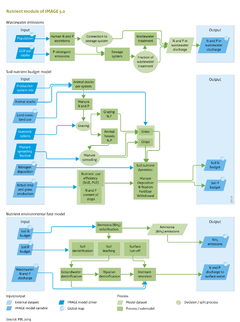Nutrients/Description: Difference between revisions
Jump to navigation
Jump to search
No edit summary |
No edit summary |
||
| Line 23: | Line 23: | ||
====Manure==== | ====Manure==== | ||
Total manure production is computed from animal stocks and N and P excretion rates (Figure Flowchart, middle). IMAGE uses constant N and P excretion rates per head for dairy and non-dairy cattle, buffaloes, sheep and goats, pigs, poultry, horses, asses, mules and camels. Constant excretion rates imply that the N and P excretion per unit of product decreases with increased milk and meat production per animal. | |||
N and P in the manure for each animal category are spatially allocated to mixed and pastoral systems. In each country and system, the manure is distributed over three management systems: grazing; storage in animal housing and storage systems; and manure used outside the agricultural system for fuel or other purposes. The quantity of manure assigned to grazing is based on the proportion of grass in feed rations (Figure Flowchart, middle). | N and P in the manure for each animal category are spatially allocated to mixed and pastoral systems. In each country and system, the manure is distributed over three management systems: grazing; storage in animal housing and storage systems; and manure used outside the agricultural system for fuel or other purposes. The quantity of manure assigned to grazing is based on the proportion of grass in feed rations (Figure Flowchart, middle). | ||
| Line 54: | Line 54: | ||
====In-stream nutrient retention==== | ====In-stream nutrient retention==== | ||
The water that enters streams and rivers through surface runoff and discharges from groundwater and riparian zones is routed through stream and river channels, and passes through lakes, wetlands and reservoirs. The nutrient retention in each of these systems is calculated on the basis of the nutrient spiralling ecological concept, which is based on residence time and temperature as described in ([[Beusen et al., submitted]]). | The water that enters streams and rivers through surface runoff and discharges from groundwater and riparian zones is routed through stream and river channels, and passes through lakes, wetlands and reservoirs. The nutrient retention in each of these systems is calculated on the basis of the nutrient spiralling ecological concept, which is based on residence time and temperature as described in ([[Beusen et al., submitted]]). | ||
}} | }} | ||
Revision as of 16:33, 20 May 2014
Parts of Nutrients/Description
| Component is implemented in: |
| Components: |
| Related IMAGE components |
| Projects/Applications |
| Key publications |
| References |
